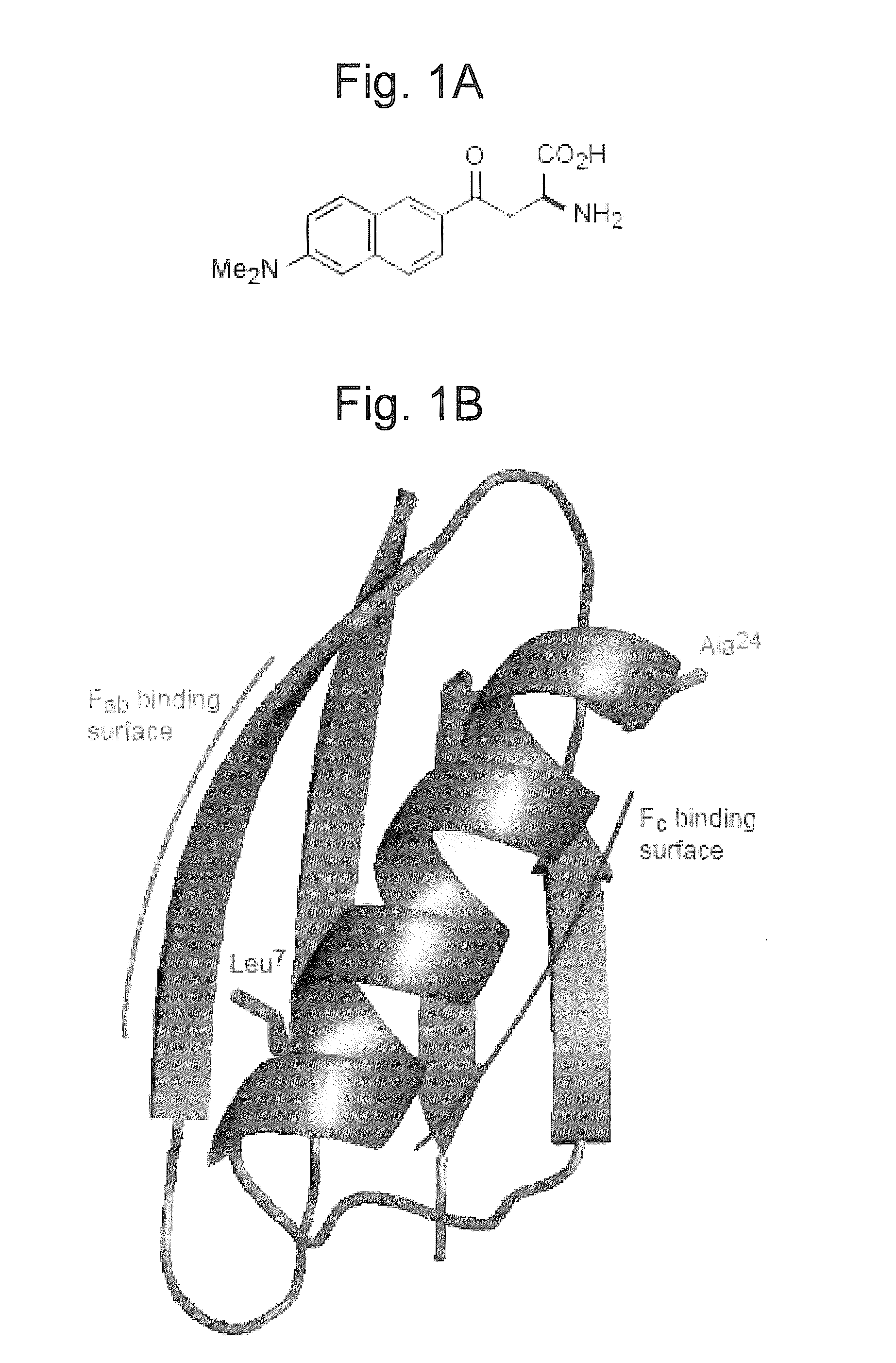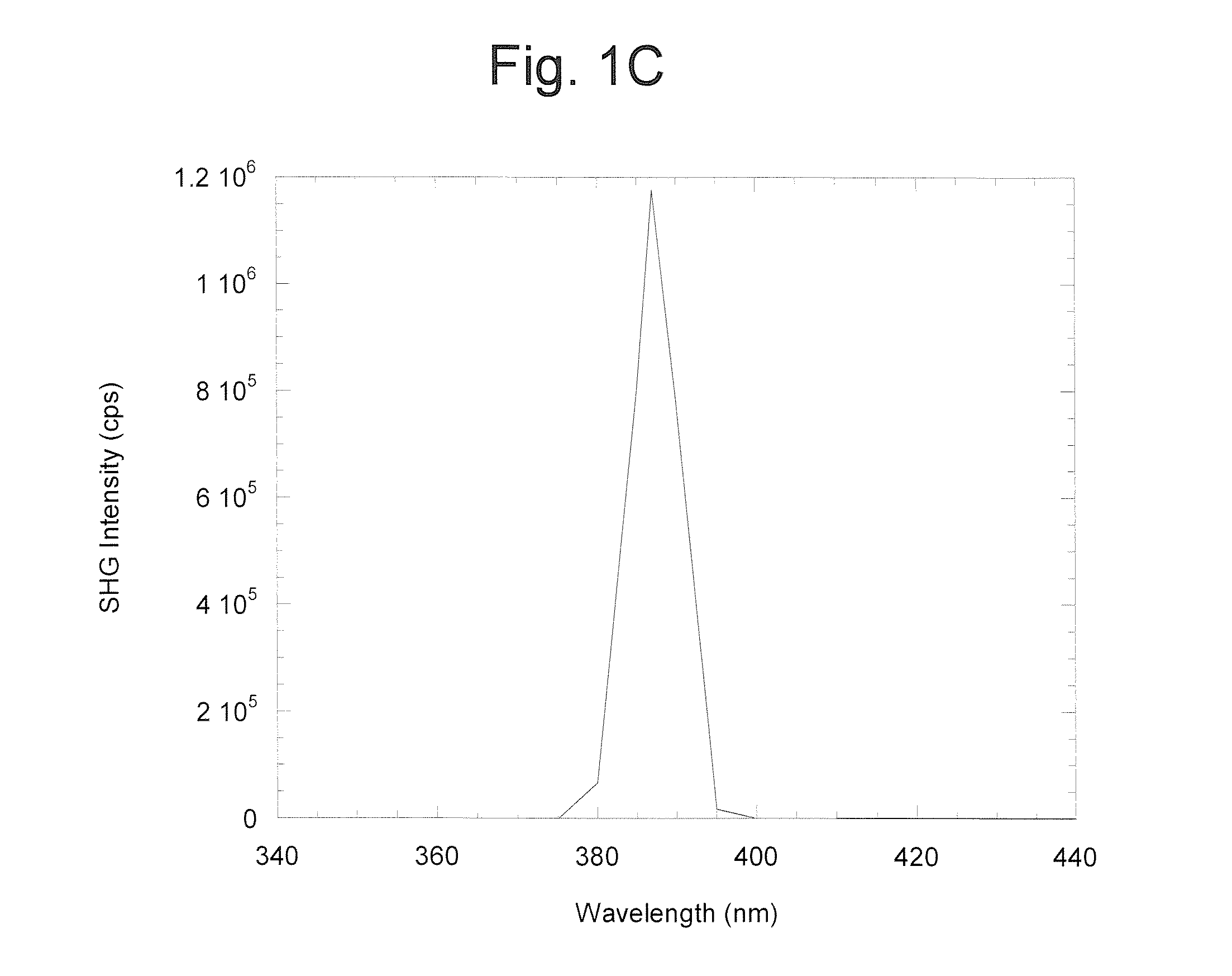Nonlinear optical detection of molecules comprising an unnatural amino acid possessing a hyperpolarizability
a technology of unnatural amino acids and optical detection, applied in the field of nonlinear optical detection of molecules comprising an unnatural amino acid possessing a hyperpolarizability, can solve the problems of inability to determine the structure of the drug, neither of these techniques is suitable for real-time structural change measurement, time- and labor-intensive,
- Summary
- Abstract
- Description
- Claims
- Application Information
AI Technical Summary
Problems solved by technology
Method used
Image
Examples
example 1
[0037]An unnatural amino acid, Aladan, which possesses a hyperpolarizability, as determined by standard means known to those skilled in the art, is incorporated into maltose binding protein in E. coli, purified and expressed.
[0038]A baseline second-harmonic signal is generated using a Ti:Sapphire laser totally internally reflected from a suitable surface such as a polystyrene coverslip, available commercially from Newport Corp. or Coherent Inc. Details of the experimental set-up and recording of the data are described in Salafsky, 20063. The surface is mounted on and index-matched to a prism through which the fundamental and second-harmonic beams pass. A rubber gasket is placed on the surface to define a well with a volume of about 100 microliters. Aqueous buffer is added to the well. The wavelength of the fundamental is tuned to about 720 nm and the power is maximized. The SH baseline is recorded continuously using a filter to block the fundamental beam, a photomultiplier and singl...
example 2
[0040]An unnatural amino acid that is second-harmonic active is incorporated into a single site in 10 different adenylate kinase mutants, each with the probe in a different site, according to procedures known to those skilled in the art. The protein mutants are isolated and purified according to standard means. The mutants are optionally screened for both activity and ability to generate second-harmonic radiation at an interface to determine the kinase that is both most native-like (e.g., in Km, Vmax, etc.) and also competent for generating second-harmonic radiation. For generating the second-harmonic radiation, the kinase proteins are adsorbed to a polystyrene surface.
example 3
[0041]A series of mutants of maltose binding protein, which each possess a SHAA probe at a unique site, is created. A his-tag at the C-terminus is used to orient the protein on a Ni-NTA-bearing lipid bilayer according to protocols known to those skilled in the art. The mutant proteins containing the probes are bound to the bilayer specifically via the His-tag to create a defined, oriented population of protein. The absolute tilt angle of the probe in each mutant is measured according to well-established procedures. The tilt angles of the probes measured by SHG are used to create a three-dimensional model of the side-chain orientation and, by modeling, the three-dimensional structure of the entire protein. This SHG determined structure can be then compared with the X-ray crystal structure to heuristically improve the modeling, if necessary. Addition of lactose will induce a conformational change in the protein that can be resolved as a motion picture in real space and real time by me...
PUM
| Property | Measurement | Unit |
|---|---|---|
| Angle | aaaaa | aaaaa |
| Structure | aaaaa | aaaaa |
| Physical properties | aaaaa | aaaaa |
Abstract
Description
Claims
Application Information
 Login to View More
Login to View More - R&D
- Intellectual Property
- Life Sciences
- Materials
- Tech Scout
- Unparalleled Data Quality
- Higher Quality Content
- 60% Fewer Hallucinations
Browse by: Latest US Patents, China's latest patents, Technical Efficacy Thesaurus, Application Domain, Technology Topic, Popular Technical Reports.
© 2025 PatSnap. All rights reserved.Legal|Privacy policy|Modern Slavery Act Transparency Statement|Sitemap|About US| Contact US: help@patsnap.com



